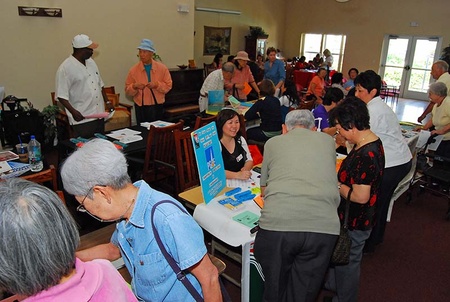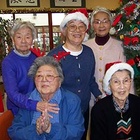West Coast Nikkei eldercare organizations are preparing for a time in the not-too-distant future when Nikkei alone will no longer fill their programs and beds. This was the universal message I heard from the seven organizations I surveyed. Yet at the same time, I sensed a desire to hold on to the Japanese cultural identity that is at the core of organizations such as Keiro Senior HealthCare in Los Angeles and Kimochi, Inc. in San Francisco.
We California Nikkei, especially the Issei and Nisei generations, are a community that formed insular pockets within Caucasian communities. My Issei grandmother, who lived in the United States for 85 years, never really learned to speak English. There was no need: she read Japanese newspapers, watched Japanese television, and socialized with family and Japanese-speaking friends. Her cultural cocoon in some ways allowed her to stay suspended in time, using archaic kanji in her letters to Japan that many could not recognize, and preserving memories and customs that modern-day Japan was quickly leaving behind.
My grandmother’s hybrid, pocket culture lives on in Nisei social groups, churches, clubs, community and senior centers. Yet some Nikkei eldercare organizations, responding to the evolving realities of community demographics, have broadened their services to cater to other languages and cultures. The most multi-culturally far-reaching of these is The Asian Community Center of Sacramento Valley (ACC).
The ACC includes a 99-bed skilled nursing facility as well as respite care, transportation services and classes for seniors. The center recently formed a new non-profit, Meals on Wheels by ACC, which operates the senior nutrition program that the County of Sacramento managed for over 30 years.
The 130 ACC staff members are impressively multi-lingual, including speakers of Japanese, Tagalog, Spanish, Mandarin, Cantonese, Toisan, Taiwanese, Hindi, and English. More than any kind of prescience about the dwindling numbers of Nikkei seniors, though, the multi-cultural aspect of the center was born of necessity. In the early 1970s, says Donna L. Yee, CEO of ACC, a coalition of Japanese American Citizen’s League, church and community group members rallied to build a Japanese nursing home. Chinese community leaders, meanwhile, dreamed of creating a separate nursing home to cater to their elderly population. By the mid-1970s, as it dawned on these two groups that they lacked the population and the fundraising capacity to each build their own centers, the idea of an Asian Community Center emerged.
The 1970s was a time of consolidating various federal jobs and vocational training programs, and of the growing role of state governments in administering these programs. The federal Congregate Nutrition Services program for the elderly, for example, established in 1972, provided meals and related nutrition services to seniors at senior centers and other community venues. Both the Japanese and Chinese Sacramento community groups realized that by joining forces, not only would they be more likely to raise the money they needed to build their facility, they would also have a better chance to claim their share of government funds and make sure elders in their community received the care they needed.
Although their languages were different, their cuisines were compatible. As Asians, they were culturally more similar to each other than to non-Asian ethnic groups. Once established, the ACC in turn produced about 20 spin-off organizations, says Yee, including a job training and mental health counseling program. Throughout, the focus of the ACC remained on the wellbeing of older adults.
As with other Nikkei eldercare agencies, the ACC’s founders were not healthcare professionals, but community leaders, including small business owners, and county and state employees. Yee notes that the ACC has benefitted from the unique make-up of its Asian population. As the state capitol and county seat, a large portion of Sacramento’s Asian American residents work in the public sector. This highly stable workforce of multi-generational career civil servants—less vulnerable to discrimination and the vagaries of the economy than Asian small business owners or corporate employees—created a rich pool of community leaders and volunteers. The result: an active force of 400 older adult volunteers, many of whom have secure pensions.
The large number of state employees among the ACC community has also been a financial boon to the facility, rendering its balance sheet more robust than Asian eldercare organizations in other cities. Many residents, explains Yee, took advantage of a period of generous California Public Employees’ Retirement System (CalPERS) benefits, which included long-term care insurance for themselves and their parents. Most of the center’s $13 million budget is financed by revenue from insurance or out-of-pocket, fee-for-service nursing home income: Lifelong learning and wellness classes cost a mere $4 per class hour, and the ACC suggests a donation for ACC Rides Transportation Services. Fund development efforts are varied. In addition to national and local foundation grants, fundraisers and individual donations supply approximately $750,000 per year, according to Yee.

ACC Nursing Home residents enjoy Tai Qi to promote their health (Photo courtesy of Asian Community Center)
Following the industry trend, the ACC is shifting from caring for more long-term patients more short-term rehabilitative care patients at the ACC Nursing Home. The shift is happening for two reasons. First, patients who are not seriously ill are leaving nursing homes for lower cost assisted-living facilities. Second, Medicare patients are being discharged from hospitals much more quickly than before, which means a longer period spent in rehabilitative care. To add even more incentive for eldercare facilities to change, Medicare reimbursements for rehabilitation services can result in revenue that is often more than double the MediCal rate for long-term nursing home care. Under this revised business model, the ACC has dramatically increased the number of residents it serves. Admissions jumped from about 30 individuals in 2001 to 160 in 2009, says Yee.
Each year, as part of its budget process, ACC reviews its operating and capital costs and compares possible rate increases against a survey of other nursing homes in the surrounding area. “We’ve been able to meet the needs of a greater number of frail elders in our community by doing better than ‘break even’ and applying additional funds to programming and capital improvements that support operating goals and objectives,” says Yee.
About 60 percent of ACC residents are Asians, and 40 percent non-Asians. As the Asian ethnic make-up shifts, says Yee, the nursing home is beginning to hire more Hmong, Lao, and Vietnamese certified nurse assistants to cater to these growing ethnic groups among the residents.
Yee has no worries that Nisei and Sansei will want to go elsewhere as the ACC becomes increasingly diverse. “It’s highly likely that they will want to [come to ACC],”she says, “Our nursing home has been rated among the best in Sacramento…it may be as much about the quality of care as the fact that we are Asian.”
Instead of the Japanese culture-specific activities and foods featured at facilities such as those of Keiro Senior Healthcare, the ACC offers a range of Asian foods and activities. The dining room serves rice often, and juk (rice congee or porridge) is always an option, along with oatmeal, eggs and toast. At dinner, there is always an Asian and a western entrée option; teriyaki chicken is one popular choice.
The ACC is also incorporating innovative ideas in eldercare, becoming more oriented to allowing individual choice and privacy among residents. Grouped under the rubric “culture change,” elements of this approach include allowing residents to choose when they wake in the morning, when they eat, and offering a greater variety of food options. Quality-of-life considerations such as the absence of loudspeaker announcements; meal services on real dishes, cups and glasses, and care activities organized at a “neighborhood” level (within a ward or wing of the nursing home) also set ACC apart, adds Yee.

Nursing Home residents, Greenhaen Terrace residents, and volunteers make the Annual ACC Craft & Bake Sale a success (Photo courtesy of Asian Community Center)
Yee understands the challenges facing Nikkei eldercare facilities that are not as multi-cultural as the ACC. She foresees the possibility of some of these facilities merging with other Asian facilities in order to stay open as Nikkei senior populations dwindle and more assimilated Sansei and Yonsei are tempted by a wide range of competing eldercare options.
Another possibility is that some Nikkei homes might find such change too difficult to make. Becoming more multi-cultural, Yee believes, “is one of the main challenges for community organizations. Being multicultural doesn’t have to take away from an organization’s mission or its founders’ vision, it doesn’t have to take away from Japanese cultural values,” she asserts. “It does mean that people have to make more room at the table.”
© 2010 Nancy Matsumoto







